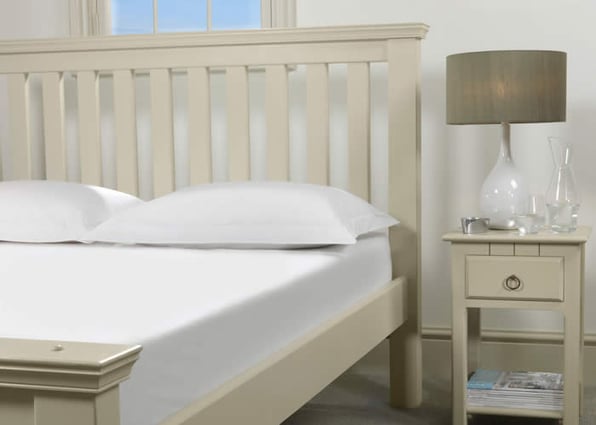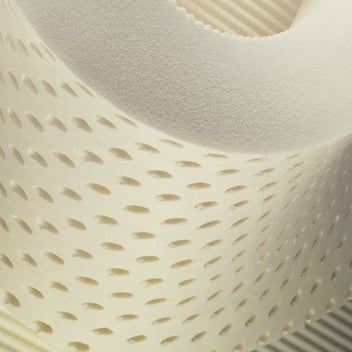How To Clean A Mattress
Unless you take the proper precautions, mattress stains are inevitable, and can quickly become odorous, impacting your quality of sleep. But if you’re able to tackle stains when they’re fresh – before they become deeply embedded in the mattress fibres – you can save yourself the cost of a replacement or costly cleaning service.
This comprehensive guide to mattress cleaning will help you address any type of spill or stain, offering clear, concise guidance on restoring the fresh look of various types of mattresses as well as heaps of other advice and restoration tips.
This guide will help you figure out:
- When to clean your mattress.
- Why you need to clean your mattress.
- How to maintain your mattress.
- How to clean your dirty mattress.
- How to remove nasty stains – blood, urine, vomit, mould, sweat, and water-rings.
- How to freshen up a smelly mattress.
- How to clean different types of mattresses.
- What to do when it’s time to change your mattress.
When to clean your mattress
Got a small stain or two on your mattress? Cover it up with a freshly washed sheet. No time to clean that large wine spill? Just flip the mattress and the stain is gone, right?
According to the experts at Fantastic Mattress Cleaning, these shortcuts deliver no benefit to the durability and lifespan of your soft bed furnishing. Not to mention your beauty sleep, which heavily depends on having a fresh and clean bed.
It’s time to stop tossing and turning and get your mattress back in order, here are some top tips for when you should clean your mattress.
- As soon as a spill occurs – tending to the spill immediately will improve your chances of removing the stain.
- At first sight of a stain – older stains, whether it from sweat, blood, or urine are always harder to remove.
- Once a week – if you’re asthmatic consider cleaning your mattress regularly – millions of dust mites take refuge on your mattress (use a HEPA vacuum cleaner and consider getting a professional heat treatment or hot water extraction).
- In spring and summer – if you suffer from hay fever or are allergic to pollen, it’s possible to reduce your symptoms by taking proper care of your mattress.
- Twice a month – tie this chore to changing your sheets and vacuum the mattress to remove dust, dead skin flakes, and other particles.
- Twice a year – resort to a professional cleaning service to extend the life of your mattress.
Why you need to clean your mattress
Did you know that, on average, you spend about a third of your life in bed? That equates to roughly 25 years in a lifetime and emphasises the importance of mattress cleaning.
Jonathan Prichard, CEO and founder of MattressInsider.com says while you may be changing your bedding often enough, if you don’t take good care of your mattress, hygiene will be impacted significantly. In fact, it’s now estimated that cleaning your mattress ranks alongside washing your clothes when it comes to hygiene.
On top of that, a neglected mattress means less chance for you to spot a bed bugs problem early on, which can lead to health complaints as well significant sleep disruption, and, last but not least, if not maintained and cleaned regularly, your mattress won’t last the average time of eight years.
Facts about your mattress
- Do you know that the average adult produces almost 300ml of sweat each night?
- Do you know that the average bed has more than 10,000 dust mites?
- Do you know that the average adult sheds about 500g of skin per year?
How to maintain your mattress
To keep a mattress clean you must:
- Avoid eating and drinking in bed.
- Use a mattress pad for protection.
- Put a waterproof mattress cover on your children’s mattress.
- Get a protector for your mattress.
- Change sheets regularly.
- Keep pets off beds.
- Flip your mattress a few times a year (if applicable) to air it well.
How to clean your dirty mattress
One good idea is to get into the habit of cleaning your mattress at the same time as cleaning the soft furnishings around your house, or when changing the bedding. So, when it comes to cleaning time each month, ensure that you:
- Vacuum the mattress well by utilising the upholstery attachments for more effective results.
- Consider investing in a quality HEPA vacuum cleaner to remove and keep allergy triggers at bay.
- Air out and deodorise the mattress before covering it with a clean sheet.
- Treat any stains by using the techniques, described below.
How to remove nasty stains
Mattress stains can be caused by a variety of substances, and each requires a different approach to remove. Here we list some common examples.
How to clean blood stains from a mattress
Materials required:
- Clean cloth
- Salt
- Bicarbonate soda
- Cool water
- Hydrogen peroxide
- Meat tenderiser powder
Method:
- Dampen a cloth in cool water and blot the stain. Make a paste by mixing the salt and soda with some water and apply on the spot. Leave the mixture to sit for ½ an hour and then wipe again with a wet cloth.
- Mix 1 part of dishwashing soap with 2 parts of hydrogen peroxide. Apply the solution on the stain and allow to work for a few minutes. Wipe off with a clean wet cloth.
- To remove old blood stains, wet the stain and make a paste with a meat tenderiser powder and water. Cover the stain with it and leave for 30 min. Clean the mixture residue with a wet cloth. The meat tenderising product contains bromelain and papain - enzymes, derived from pineapple and papaya. They effectively break down proteins and separate amino acids present in the blood, making it easier to remove the stain.
How to clean urine stains from a mattress
Materials required:
- Cloth
- Paper towel
- Water
- White vinegar
- Baking soda
- Upholstery cleaner
Method:
- Treat fresh urine stains straight away by absorbing via paper towel as much of the liquid as possible. Then spray the area with 1:1 solution of water and white vinegar. Blot gently with a cloth. Repeat the procedure if needed, wipe clean the spot with a wet cloth, and leave to air dry.
- You can use the same method for old urine stains with the difference that you can sprinkle some baking soda over the stained area. Leave to sit overnight and vacuum the soda residuals the following day.
- Instead of vinegar and soda, you can use an upholstery cleaning product to treat old, dried urine stains. Dampen the area and follow the label instructions on the product.
How to clean vomit stains from a mattress
Materials required:
- Cloth
- Hydrogen peroxide
- Baking soda
- Essential oil
Method:
- Pour some hydrogen peroxide over the affected area.
- Ensure you don’t over-wet the area.
- Leave the substance for 5-6 minutes and blot out with a cloth.
- Sprinkle some baking soda mixed with a few drops of your favourite essential oil and allow the mixture to work overnight.
- Vacuum the residue on the next morning.
How to clean sweat stains from a mattress
Materials required:
- Sponge
- Borax
- Powdered washing detergent
- Water
Method:
- Wet the stain slightly with water and sprinkle some Borax powder over the area. Work the substance in with a sponge and leave until the mattress dries and then vacuum the residue. Repeat if necessary.
- Mix some washing powder with warm water and use a sponge to cover the stained area with the detergent. Rub in the solution in a circular motion until you notice that the stain is beginning to fade. Then rinse the sponge well and wipe the soap suds off. Leave the mattress to air dry.
How to clean water-rings from a mattress
Materials required:
- Wet cloth
- Paper towel
- A hairdryer
Method:
- Dampen the area with water, diluting the circle and turning it into a new wet stain.
- Grab some quality kitchen paper and put a few layers over the wet spot.
- Place something heavy on top like a book.
- Change the paper towels a few times and use a hairdryer to speed up the drying process.
How to freshen up a smelly mattress
Your mattress may not be badly stained but with consistent everyday use, it can often start to smell over time. Sweat, mixed with microscopic organisms, can produce a stale whiff if you don’t clean and air your mattress on a regular basis.
There is more than one way of how to deodorise and remove bad odours from your mattress. This method uses just two materials: baking soda and a few drops of essential oil.
Method:
- Sprinkle or dust a good amount of baking soda, mixed with some essential oil, over the mattress.
- Leave for at least an hour.
- Vacuum the surface. Baking soda will absorb any musty odours, unlike some store-bought products, which only cover up bad smells.
How to clean different types of mattress
Mattresses come in all shapes, sizes, and specifications and each has its own special method of cleaning. Here we provide examples of how to clean different types of mattress, taking into consideration any specific precautions you should take so that you don’t end up damaging the mattress in the process.
How to clean a memory foam mattress
The most important thing to remember when cleaning a memory foam mattress is to use only a moderate amount of liquid. Foam is a super-absorbent material, so if saturated with water, it could take an eternity to dry; possibly causing mildew problems and mould growth.
Materials required:
- Vacuum
- Borax/baking soda
- Powdered washing detergent
Method:
- Vacuum the surface thoroughly.
- Dry clean and deodorise the mattress by sprinkling borax or baking soda.
- You can also gently spray the surface with a fabric cleaner.
- Allow to sit for an hour and then, vacuum again to remove all the residues.
- Treat any stains by choosing an appropriate method and by using as little liquid as possible.
- Always make sure that you dry the mattress completely.
- Avoid steam cleaning your memory foam mattress.
If your memory foam mattress can’t be cleaned and you’re in need of a new one, check out our range.
How to clean a latex mattress
Latex mattresses are made from natural materials, derived from rubber trees. What you need to remember here is that water is not the biggest enemy when it comes to cleaning natural latex – harsh chemicals are. So, we recommend that you use natural, homemade solutions to avoid damage.
Materials required:
- Vacuum
- Borax/baking soda
- Essential oils
- Water
- Vinegar
Method:
- Thoroughly vacuum your latex mattress.
- Sanitise and remove stale odours by dusting the surface with bicarb soda, mixed with a drop or two of some essential oil.
- Treat any stains with organic substances, such as vinegar, soda, alcohol and enzyme cleaner, depending on the nature of the stain (refer to the tips above).
- Dry out the mattress before placing a clean sheet.
If you require a new mattress, then check out our range of latex mattresses.
What to do when it’s time to change your mattress
A worn out mattress can impact sleep patterns and quality of sleep, and in some extreme cases even impact the health of the owner, so it’s important to know when you should change your mattress.
After all, no matter how much you clean and air your mattress, nor how good you make it, there comes a point when it simply stops serving you as it should. From waking you up with a backache or a stiff neck to not being able to fall asleep until the small hours of the night – all these signs indicate that your badly warped and discoloured mattress has reached the end of its lifespan.
In cases where your mattress is beyond repair, and you need to purchase a new mattress, the first thing you’ll want to do is gather information about possible replacements and their benefits and limitations, for this, you should consult a Mattress Buying Guide. Once you know which mattress is right for you, then choose from a range of Pocket Sprung Mattresses, Latex Mattresses and Memory Foam Mattresses.
download your free Brochure
To find out more about Revival Beds, click on the link below to download your free brochure.






